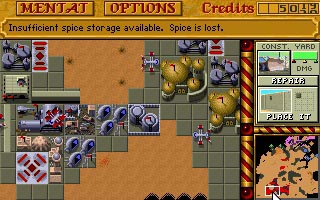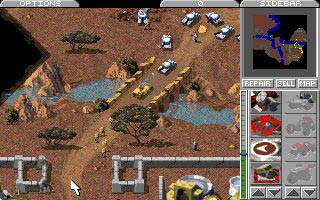Real-time strategy games
Dune II (1992)

Dune II set many of the standards for real-time strategy
Hardware: IBM PC
- Intel 386 @ 16 MHz
- 3 MB RAM
- 64KB VRAM
- Hard disk
- Mouse
- VGA (256 colors)
- 320x200 resolution
Dune II was nothing at all like its predecessor, a fairly standard adventure game. The sequel threw all the rules out the window, and defined a new genre all of its own, something that happens rarely in video gaming.
There are some who look at earlier titles like Herzog Zwei on the Sega Genesis and call it the true father of real-time strategy, but having played that game I find it difficult to describe it as such. Dune II laid down many of the conventions that became standard for all real-time strategy (RTS) games to come, and it looked and played very different from Herzog Zwei. The elements included building your own base from the ground up, sending mining units out to gather resources which could be spent on more buildings or attack units produced from those buildings, building up an army, and finally sending that army over to the opposing base and attempting to destroy it. The player could use the mini-map to view the entire field of battle at once, but until areas had been explored they remained dark, which made the early stages of the game very exciting.
In Dune II, set on the planet Arrakis from the science-fiction novel series of the same name, the main resource was spice, gathered by harvesters. Harvesters could be attacked and eaten by spice worms who buried deep underneath the sand. Dune II required that the player build large concrete slabs and lay them down below any further buildings could be placed (you could place buildings on raw sand but they would quickly fall into disrepair) There were three sides, Artreides House, Harkonnen House and Ordos House, and the player attempted to conquer Arrakis with all three. Each side had the same units plus some special units (such as the devastating Artreides Sonic Tank) that were special to that House.
The game was strictly a single-player affair against the computer. The computer had rather boneheaded AI and would gladly throw dozens and dozens of units against your base even if it was well defended by turrets. This lack of AI smarts would prove necessary in the last few missions, where your opponent started with a huge base to begin with, and memory limits in the game prevented you from building many units until you destroyed some of the computer's.
Despite these limitations, the game was insanely fun to play and remains so today. An updated version of the game, Dune 2000 was released to mark the end of the millennium but it did not sell particularly well, as it was facing many competitors in the genre that it originally created.
Command and Conquer (1995)

Command and Conquer added multiplayer action
Hardware: IBM PC (486 @ 25 MHz)
Command and Conquer was another release from Westwood, which had originally created Dune II. In C&C, the player was placed into a near-future world where the Global Defense Initiative battled the evil forces of NOD for world domination. The game featured a full-motion, live-action video introduction and cut scenes, and had a pulse-pounding soundtrack
The graphics had a stronger isometric arrangement, and units had more frames of animation. Some new game play features made things easier on the player: you no longer had to place concrete slabs down before the buildings, you could group multiple units more easily, and you could stack building orders in your barracks and factories so they would continue to produce units without constantly watching them.
The best feature of the game was its multiplayer, available over local area network or dial-up modem. I had many hours of happy memories blasting (and being blasted by) my friends while playing this game. I still have nightmares about swarms of NOD motorcycles coming at my base from all directions.
The game was extremely popular. Its sequel, Command and Conquer: Red Alert sold two million copies within a year of its release.
Warcraft II (1996)
Hardware: IBM PC (486 @ 25 MHz), PowerPC (PPC 601 @ 60 MHz)
Warcraft was Blizzard Entertainment's answer to Dune II and Command and Conquer. The original game came out between those two titles, but it was the sequel that garnered significant attention. The move to SVGA made the units much clearer and more detailed, and small touches like having the units complain if you clicked on them too many times in a row enhanced the overall game. In the Warcraft world, Orcs and Humans battled each other with units that looked different but had basically equivalent powers (although it is generally acknowledged that for human players, Ogres with Bloodlust outclassed Paladins with Heal because they were easier to manage in large numbers.)
The game introduced a new concept for RTS, the "Fog of War." No longer would merely exploring an area with a single unit cause it to be visible for all time. The landscape would be unveiled, but unless a friendly scout unit maintained its presence, enemy troop movements would be invisible. This added a significant dimension to strategy.
The game allowed you to complete two full campaigns against the computer, one as the Orcs and the other as the Humans. Multiplayer was supported via local area network and dial-up modem. A later re-release allowed players to connect over the Internet using Blizzard's matchmaking service, Battle.net.
Total Annihilation (1997)
Hardware: IBM PC (Pentium @ 100 MHz)
Total Annihilation upped the RTS ante by rendering all of the units in 3D, so their movements were completely smooth no matter what direction they were facing in. The backgrounds were hand-drawn, but took into account elevation, so units firing down from higher ground gained advantages over their unfortunate foes below. The game took a slightly different direction from other RTS' titles with the introduction of the Commander, a master unit that cannot be destroyed without losing the game and has certain special features including the ability to build other units.
The game featured a plethora of units and free expansion packs added even more. The game developed quite a community following, which has survived to this day even though the original maker, Cavedog Entertainment, did not.
Starcraft (1998)
Hardware: IBM PC (Pentium @ 100 MHz)
In 1997, Blizzard leaked some screen shots of an early alpha of Starcraft, basically Warcraft in space, based on the Warcraft II engine. The response was lukewarm, so Blizzard decided to write a new engine from scratch. Starcraft was the result. It featured three very different races, the scrappy Terrans, the prolific Zerg, and the ancient and dignified Protoss. For the first time, units from the three races did not mirror each other but had very different abilities and strengths.
For example, Terran buildings could take off and fly (slowly) and resource gatherers could repair damaged units. Zerg could build any available unit at any hatchery. Protoss units took longer to build but had greater strength and had extra protection from shields. The result was a rock-paper-scissors type game where each race had units that were more effective against specific units, but in turn were more vulnerable to others.
Three single-player campaigns were included in Starcraft, one for each race, and numerous multiplayer modes were available over local area network or the Internet through Battle.net. An expansion, Brood War, added more units and balanced the sides still further. It was the extreme balancing of one-on-one battles that made Starcraft multiplayer games extremely popular, and in South Korea today the top players are showcased on four full-time Starcraft TV channels and are treated like superstars.
Warcraft III (2002)
Hardware: IBM PC (Pentium II @ 400 MHz)
Warcraft III attempted to emulate the art style of its immediate predecessor, but this time in full 3D glory. The player could zoom in closely to the action or zoom out to emulate the old isometric view. However, full camera freedom was not implemented, presumably to simplify game play (there had been some earlier RTS games that allowed this, and it tended to get confusing very quickly.) The zoomed-in effect was used in all of the game's cut scenes, allowing a greater immersion into the storyline.
The game operated much like Warcraft II on the surface, with the addition of new playable races such as the Undead and Night Elves. The significant game play change was the addition of heroes, special units with extra stamina and skills, who could gain experience and use special items. This was a fusion of role playing elements into the traditional RTS genre, and the reaction of the gaming public was generally favorable. Warcraft III would go on to sell over five million copies, and inspire the creation of a massively multiplayer game based on its world and story.




reader comments